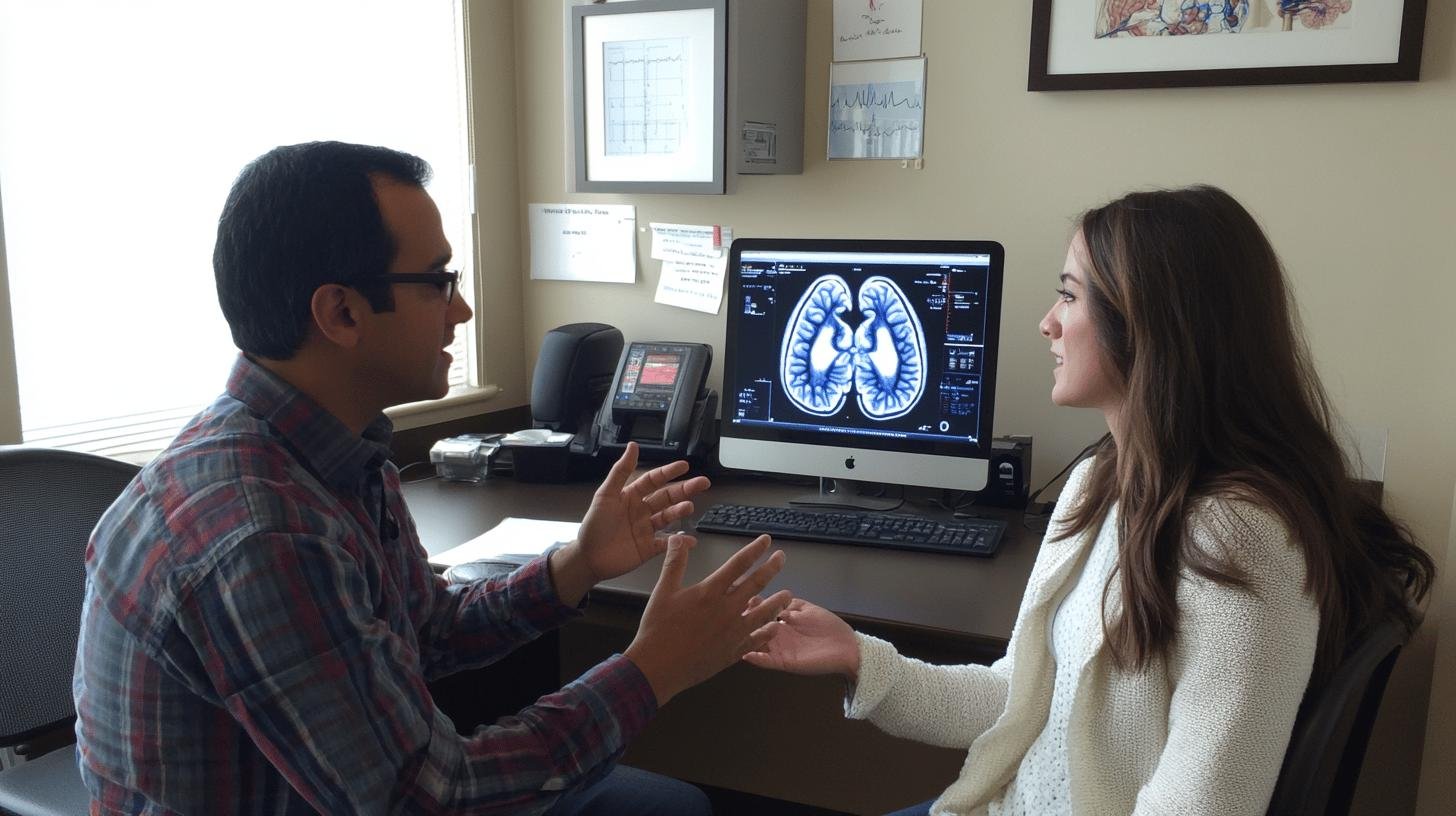TL;DR:
- The human nervous system is essential for thoughts and movements; over 600 neurological diseases exist.
- Major diseases: Alzheimer’s, Parkinson’s, Epilepsy, Multiple Sclerosis, Huntington’s.
- Symptoms often shared: pain, tingling, numbness, paralysis.
- Alzheimer’s: memory loss; Parkinson’s: tremors and stiffness; Huntington’s: jerky movements, cognitive issues.
- Epilepsy causes recurrent seizures; it is managed via medication/surgery.
- Multiple Sclerosis: affects myelin, causing paralysis, sensory issues, and vision problems; management includes lifestyle changes, medication, and physiotherapy.
- Disorders categorized as Peripheral (e.g., neuropathy) and Central (e.g., stroke).
- Innovations include gene therapy, personalized medicine, neurostimulation, and stem cell research.
Ever wonder why your body’s wiring sometimes goes haywire? Our nervous system is like the command centre for all our thoughts, responses, and movements. But what happens when it malfunctions? There are over 600 ways it can go wrong, affecting everything from memory to mobility. From Alzheimer’s to epilepsy, these major diseases of the nervous system and neurological disorders can really send our bodies out of whack. Let’s dive into the complexities of these nervous system diseases and understand what makes them tick. Ready to geek out with me about the nuts and bolts of the brain?
Understanding Major Diseases of the Nervous System
The nervous system is the body’s control centre. It influences everything: thoughts, movements, and even reactions to hot coffee. Thousands of neurons send messages throughout the body. They enable you to walk, talk, and remember where you left your keys. With such an essential role, it’s no surprise the nervous system is complex. When it malfunctions, it can lead to severe issues.
There are over 600 neurological diseases—yes, that’s a lot! These disorders affect individuals differently. Some impact memory, like Alzheimer’s. Others disrupt movement, like Parkinson’s. Epilepsy leads to seizures, and multiple sclerosis causes sensory issues. There are a range of major neurological conditions, each with unique characteristics.
- Alzheimer’s Disease
- Parkinson’s Disease
- Epilepsy
- Multiple Sclerosis
- Huntington’s Disease
What ties these diseases together? Many share symptoms like pain, tingling, numbness, and even paralysis. It’s as if your body’s alarm system is malfunctioning. Imagine moving your hand but feeling like wires are crossed. These symptoms highlight the importance of the nervous system and why we must keep it healthy.
Neurodegenerative Diseases: Symptoms and Causes

Neurodegenerative diseases involve nerve cells losing function or dying, which negatively affects the brain and body. They are often linked to inflammatory cells or harmful proteins.
Alzheimer’s Disease
Can’t find your parked car? For Alzheimer’s patients, that confusion is amplified. Memory loss is significant, alongside changes in behaviour. Familiar places become strange due to brain cells failing to work, causing frustrating lapses.
Parkinson’s Disease
Parkinson’s affects movement and causes tremors. The brain produces less dopamine, a chemical necessary for smooth movements. Low dopamine results in tremors, stiffness, and slow movements.
Huntington’s Disease
Huntington’s is genetic—if it’s in your DNA, it can cause jerky movements and cognitive troubles. Brain cells related to movement and thinking deteriorate, leading to these symptoms.
What causes these diseases? Genetics play a major role, especially in Huntington’s. But it’s not only about genetics. Environmental factors like toxins and poor lifestyle choices also contribute. It’s a complex interaction between genes and the environment. Understanding these diseases involves more than just examining genetic factors.
Epilepsy and Seizure Disorders
Have you ever wondered what happens during epilepsy? It’s about electrical activity in the brain going haywire. This condition involves recurrent seizures ranging from mild to severe. Imagine sitting calmly, and then suddenly, your brain’s signals act chaotically. Epilepsy is more common than many realize, affecting millions worldwide. It’s like having an overactive brain firing off signals.
| Seizure Type | Symptoms |
|————–|———-|
| Petit Mal | Brief loss of awareness, staring spells |
| Grand Mal | Muscle convulsions, loss of consciousness |
| Focal | Twitching, changes in sensation or behaviour |
How do we manage this electrical chaos? Medications are key to controlling seizures. They calm the brain’s hyperactive signals. For some, surgery might be necessary if medications don’t help. It’s like hitting a reset button for the brain. With the right approach, many people with epilepsy can lead full, active lives. Whether through medication, surgery, or both, it’s about stabilizing those brain waves.
Multiple Sclerosis: Causes, Symptoms, and Management

Multiple Sclerosis (MS) is sneaky in the world of demyelinating diseases. It breaks down myelin, the protective covering around nerve fibres. Imagine the rubber coating on a wire wearing out. When it does, nerve signals slow down or jumble, causing problems for the brain and spinal cord.
What symptoms arise? MS can throw various challenges your way. Paralysis might occur, making limb movement nearly impossible. Sensory issues like tingling or numbness might appear. Vision problems, including blindness, can result if the optic nerve is affected. It’s like an unwanted surprise party you never signed up for.
- Lifestyle changes
- Physiotherapy
- Medication management
- Stress reduction techniques
How do we tackle MS? Firstly, lifestyle changes can be transformative. Eating well and staying active keep the body strong. Physiotherapy aids in mobility and reduces stiffness. Medications manage symptoms and slow the disease’s progress. Stress-busting activities make a noticeable difference. Early detection is crucial. Spotting MS early improves management chances. Personalized care plans are essential—they fit your unique needs like a tailored suit. Proper diagnosis and treatment help keep MS in check and prevent it from dominating life.
Peripheral and Central Nervous System Disorders
The nervous system is the body’s communication highway, split into two parts: the peripheral nervous system (PNS) and the central nervous system (CNS). The PNS connects limbs and organs to the brain, akin to a network of roads leading to the city centre (CNS), which includes the brain and spinal cord. Both systems work together to maintain functionality, but disorders can lead to serious disruptions.
Peripheral Nervous System Disorders
The PNS links your limbs and organs to the brain. When disorders like neuropathy occur, nerves receive faulty signals. Neuropathy leads to tingling, numbness, or weakness, especially in the hands and feet. Imagine gripping a coffee cup but feeling as if your fingers are asleep. Another issue is Guillain-Barré syndrome, likened to an uninvited guest attacking nerves. It causes muscle weakness, possibly needing a wheelchair for a while. Most recover, but it’s a challenging experience.
Central Nervous System Disorders
The CNS, the nervous system’s commander, directs actions from the brain and spinal cord. Disorders here have major impacts. For instance, strokes block blood supply to the brain, causing paralysis, speech loss, or vision issues, depending on the area affected. Multiple sclerosis, where the immune system attacks the CNS, disrupts movement and sensation, resulting in fatigue and blurred vision.
Classifying these disorders assists doctors in deciding the best treatment approach. Knowing if a condition affects the PNS or CNS helps tailor treatments. It’s like having a map to navigate the intricate landscape of neurological disorders, simplifying diagnosis and treatment.
Innovations and Treatment Options in Neurology

Traditional treatments for neurological disorders usually start with lifestyle changes, medications, and physiotherapy aimed at symptom management and quality of life improvement. However, these methods sometimes fall short due to complex conditions. Medications may cause unwanted side effects, and physiotherapy might not suffice for severe cases. It feels like having a toolbox but missing the right tools. That’s why innovative approaches are vital to filling these gaps and offering more targeted relief.
- Gene therapy
- Personalized medicine
- Neurostimulation
- Stem cell research
Recent advancements bring exciting options. Gene therapy tweaks the blueprint to fix genetic issues from within. Personalized medicine customizes treatments akin to a tailored suit. Neurostimulation uses electrical impulses to reduce symptoms, and stem cell research explores repairing damaged nerve tissues. Also, direct primary care offers a direct route to managing neurological conditions without insurance hassles. It emphasizes personalized, comprehensive care plans, removing financial barriers and increasing access to necessary care.
Final Words
Exploring the major diseases of the nervous system gives us a peek into the complex world of neurology. We’ve covered big hitters like Alzheimer’s, Parkinson’s, epilepsy, and multiple sclerosis—each with its own set of challenges and symptoms. Neurodegenerative diseases impact memory, movement, and more, while innovative treatments continue to emerge.
Grasping what the major diseases of the nervous system are is crucial for understanding and managing these conditions. With ongoing research and personalized care strategies, there’s always hope on the horizon. Staying informed is our best defence, and a brighter, healthier future is within reach.
FAQ
Q: What are some common diseases of the nervous system?
A: Common nervous system diseases include Alzheimer’s, Parkinson’s, epilepsy, and multiple sclerosis. Each condition impacts how the nervous system functions, leading to many symptoms.
Q: What are the symptoms and treatments for nervous system disorders?
A: Nervous system disorders often present with pain, tingling, numbness, and paralysis. Treatments can include medication, physiotherapy, and lifestyle changes to manage symptoms and improve quality of life.
Q: What are the top three common nervous system disorders?
A: The three most common nervous system disorders are Alzheimer’s disease, Parkinson’s disease, and epilepsy. These conditions vary in symptoms but generally affect memory, movement, and electrical activity in the brain.
Q: What are the early symptoms of neurological disorders?
A: Early symptoms of neurological disorders include headaches, difficulty moving, memory problems, and changes in behaviour. Recognizing these signs early can lead to better management and outcomes.
Q: What are the worst diseases of the nervous system?
A: Some of the worst nervous system diseases include Alzheimer’s, multiple sclerosis, and Huntington’s disease. These conditions can lead to severe symptoms like cognitive decline, paralysis, and significant life quality reductions.

